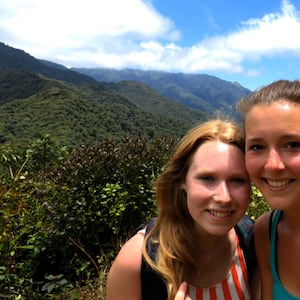AMSTERDAM—On a sunny day, the first of April 2014, two 20-something girls went for a hike in the Panamanian jungle, and were never seen again. Their names were Lisanne Froon and Kris Kremers, and their sad story struck a chord with people around the globe.
After their disappearance, the good weather vanished as quickly as the girls had. It no longer seemed to matter how many people or organizations were drummed up, or how extensive the searches were. The girls were lost, and would remain lost.
There is something about this tragic tale that haunts people to this day, and speculation about what really happened to the vanished girls never ended. Now, Dutch authors Marja West and Jürgen Snoeren claim that in their new book Lost in The Jungle, the mystery is finally resolved.
“It was 2016 and I was sitting on my veranda during a thunderstorm, in the pouring rain, at night. I was reading the coverage of the story of Lisanne Froon and Kris Kremers by The Daily Beast, in fact,” West told The Daily Beast. “The story totally fascinated me, I was thinking, ‘How would you feel as a girl in that situation?’ Deep into the woods, it’s wet, you are hungry, lost. You can’t reach your parents, you’re waiting for help that will not come. When does the hope stop? You are so young, on this beautiful adventure, an exciting holiday. Afterwards you will start your studies, your room, your study, everything is pre-arranged. And then the moment arrives, the pivotal moment you begin to accept that you will die there in the middle of the jungle. I found that so intensely sad. That’s what grabbed me.”
A few months after their disappearance, a backpack containing their phones, camera, money and some clothes washed up on the banks of the Culebra river.
On the camera, scores of photos were found, including a dark series of pictures shot at night. Panamanian authorities hoped it would shed some light on what had happened, maybe even trace back to the girls. But time was scarce and expectations were overshadowed by the near impossibility for anyone, even experienced jungle dwellers, to survive the rough terrain, endless rain and remorseless torrents created by the rainy season, now in full swing.

Roselie Kremers, mother of Kris Kremers, strokes a sniffer dog, after a search in Boquete on May 27, 2014.
Carlos Jasso/ReutersDespite the months of searches, in which no effort or expense was spared, Lisanne Froon and Kris Kremers would not be found. It wasn’t until August of that year that bits of their bones were recovered.
“Reading the articles in The Daily Beast about the case left me puzzled. What triggered us was that based on the same facts, different conclusions could be drawn. The first set of articles conjectured that the girls had met with an accidental death,” West said.
One year later, Snoeren read The Daily Beast’s follow up investigation assessing the likelihood of a murder scenario. Both scenarios were possible, West says, but which was the true version of events? Had there been too little information available to come to a solid conclusion?
“That’s when we decided to work out what had really happened for ourselves,” the author explained. “We started by looking on the internet, where it was extremely difficult to separate fact from fiction. We saw facts re-appear as if publications were copying one another. You could really move in any direction.”
A little further along their research, they got in touch with Dick Steffens, a former Amsterdam detective, who was still looking into the case on his own initiative. “What he told us blew us away,” West says, explaining that “[Steffens] said: Kris Kremers is possibly still alive.”
As if that statement wasn’t controversial enough, Steffens added that he thought the Panamanian investigation was shoddy and should be redone. “He also claimed a certain Stefan W. had come forward, saying Kris Kremers had ended up in the sex trade,” West added. “The man claimed he would be able to free her. Nothing came of it, and the family never heard from Stefan W. again.”
The meeting with Steffens left West and Snoeren stunned, and overflowing with questions.

A Boquete resident holds a candle and a missing person poster at a public vigil to find Lisanne Froon and Kris Kremers in 2014.
Carlos Jasso/ReutersFor the book, they spoke to behavioral scientists, (indigenous) guides, witnesses, police officers, lawyers, pathologists, search team members, survival specialists, forensic psychiatrists and photo specialists. Although the topic is harrowing and the reconstruction of the Dutch girls’ fate complex, West and Snoeren’s book is an easy read. Many different accounts and statements are woven into a storyline that takes the reader from the girls’ lives before their Panama trip, to their disappearance and beyond.
The real breakthrough in West and Snoeren’s investigation came when they got their hands on the complete police files, the forensic reports, the autopsy reports, and enlisted the help of former Panamanian public prosecutor Betzaïda Pitti.
Taking in all that info step by step brought them closer to those final 11 days in the lives of the girls, leading up to their death. An ending that, according to West and Snoeren, had to be accidental. “It actually came as a surprise to us too, but our conclusion had to be that it was an accident. It took us quite some time to get there.”

Books of condolence next to photos of Lisanne Froon and Kris Kremers in the city hall of Amersfoort, the Netherlands, on June 25, 2014.
Jeroen Jumelet/GettyBut there had been a turnkey moment, and it had everything to do with the way the girls’ belongings and remains were found. Snoeren had called West and told her: “With all that I’m reading now in the police file, it couldn’t be anything else… there was a certain sequence and timing to it, that had to be caused by the flash floods, typical to the region and season. Those flash floods made staging scenes or strategically placing items impossible.”
Public prosecutor Pitti, during the investigation, never responded to the allegations made against her. It was said she failed at her job. Others said she botched the investigation in order to protect the Panamanian tourist industry. In this book, Pitti wants to set the record straight.
“When I approached her for the first time she was wary, wanted to know who I was and what my take was on the case,” West said. “So I asked her if, instead of an interview, she would be willing to share the police file with us, let us translate and study it. We also asked her if she would extend her collaboration to the book. She was OK with that, and said: you can ask me anything you want.”
Debunking false information and disproving rumors became part of the core of the book. There was so much of it floating around on the internet and beyond, it created a skewed image of the situation and a false idea of what possible scenarios are. According to West, “Once we had the files, we could understand where people outside the investigation got sidetracked and why.”
After reviewing the files, the authors say they think the Panamanian authorities did an excellent job. But the enormous international attention for the case didn’t do it much good. “There was this specific moment when the reward for the critical clue went up from $3,000 to $30,000,” the author explained. “Straight after, the police were inundated by tips, each had to be checked out, losing them valuable time. It became a hell of a job.”
Most, but not all questions surrounding the case are answered in Lost in the Jungle. West admits a few hours remain unaccounted for. “From the moment the last photo was taken on April 1, to the first emergency call that day, around two hours and 45 minutes later, those are hours that we’ve been unable to reconstruct with certainty. The timeline before that is pretty exact, and the time after the first emergency call we’ve been able to reconstruct what must have happened.”
But during that small window of time, something unknown could still have happened. In cases like the disappearance of Froon and Kremers, research can shear near to the facts and take you close to the truth. But only simple, blunt facts can be absolute and truthful. And as time blurs memories, disinformation lingers. With that context in mind, the authors of Lost in the Jungle did a thorough job unraveling the mystery.



